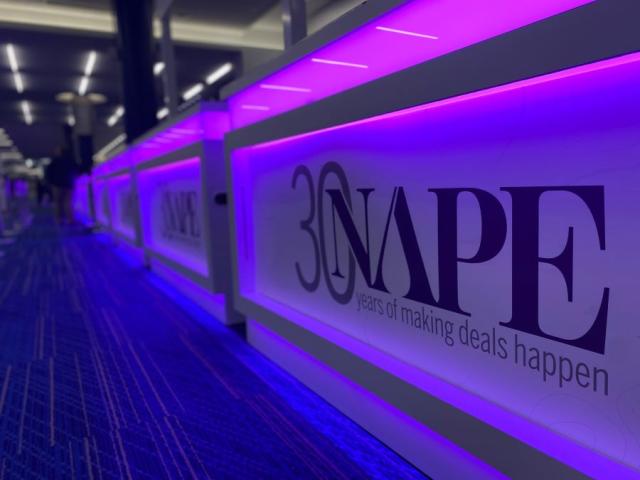
Entrance to the NAPE 2023 in downtown Houston, Texas. (Source: Hart Energy Staff)
HOUSTON – Europe and the U.K., having survived their first winter cut off from Russian gas, now must turn their attention to next winter, according to the leaders of Commonwealth LNG and Chesapeake Energy.
The energy crisis in Europe caused by the Russia-Ukraine war has awakened the world and Europe in particular to its risky reliance on Russian gas, Commonwealth LNG founder and chairman Paul Varello said Feb. 1. Varello spoke during a panel discussion alongside Chesapeake Energy chairman and CEO Nick Dell’Osso at the annual NAPE summit in Houston.
While the outcome of this winter looks promising for Europe, Varello said Europe now realizes “that it needs to be a continual tactic focus on how we now fill up for next winter and how do we avoid this eventually by getting contracts in LNG long-term.”
Recently, Asia has also joined in the mix with Europe to assure they don’t get short-changed again after having LNG cargoes redirected to Europe last year, Varello said.
Russian President Vladimir Putin’s military exercises in Ukraine last year led to a full-scale war that continues to rage on nearly a year later. U.S. sanctions on Russia — as well as key allies’ decisions to steer clear of Russian gas — has prompted an energy crisis in Europe and the U.K. due to a scarcity of gas. A combination of efforts last year to fill storage and replace Russian gas with U.S. LNG imports, coupled with a milder than normal winter, have been a lifesaver so far for Europe.
RELATED
Germany to Inaugurate Deutsche Ostsee LNG Import Terminal
“The Europeans are starting to realize it’s just good politics to have more business with America and maybe less with Russia, or even Qatar, which is right now pretty safe, but one day that could flip and then you are left with too much dependence on it,” Varello said. “Europe is looking for not another sole supplier but variety of choices.”
But next winter could be worse.
Issues in the U.S. around the permitting and building LNG export terminals remain a headwind to boosting exports, although government subsidies aren’t necessarily needed, Dell’Osso said.
“But we need to be thinking about the long-term fundamentals,” Dell’Osso said.
Uncertainties continue to confound U.S. companies considering LNG export opportunities, including facility construction costs amid an inflationary environment, shipping expenses, supply-demand fundamentals once gas reaches Europe and uncertainties around future Russian gas, which is “offline” for now.
Such uncertainties make it challenging for companies to commit to long-term contracts and make it “a challenge to break that chicken and egg problem,” Dell’Osso said.
“When you look at the long-term fundamentals, it’s very clear markets outside the U.S. will be short natural gas and the U.S. will be long natural gas,” he told the attendees. “So, we are a supplier of choice and the rest of world is very interested in solving their future supply problems, but we have not yet really cracked the code to see these contracts start come with any pace.”
After filling gas storage with Russian gas in 2022, the challenge for Europe will be refilling storage for next winter, both Varello and Dell’Osso said. They agreed the U.S. has ample gas supply for export as LNG but warned about an arbitrage market in which gas is supplied under contract then resold at higher prices.
In the future, there will be increased gas supply, whether from the U.S., Qatar or another source, followed by increasing demand. But market disconnects will eventually come together. Arbitrage profits don’t last, Dell’Osso said.
“The market for U.S. gas is expanding. The price that gas receives is expanding so we should have exposure to that but you shouldn’t assume it’s an arbitrage,” Dell’Osso said.
Recommended Reading
E&P Highlights: Jan. 29, 2024
2024-01-29 - Here’s a roundup of the latest E&P headlines, including activity at the Ichthys Field offshore Australia and new contract awards.
Deepwater Roundup 2024: Offshore Africa
2024-04-02 - Offshore Africa, new projects are progressing, with a number of high-reserve offshore developments being planned in countries not typically known for deepwater activity, such as Phase 2 of the Baleine project on the Ivory Coast.
E&P Highlights: April 1, 2024
2024-04-01 - Here’s a roundup of the latest E&P headlines, including new contract awards.
Deepwater Roundup 2024: Offshore Australasia, Surrounding Areas
2024-04-09 - Projects in Australia and Asia are progressing in part two of Hart Energy's 2024 Deepwater Roundup. Deepwater projects in Vietnam and Australia look to yield high reserves, while a project offshore Malaysia looks to will be developed by an solar panel powered FPSO.
E&P Highlights: April 15, 2024
2024-04-15 - Here’s a roundup of the latest E&P headlines, including an ultra-deepwater discovery and new contract awards.






